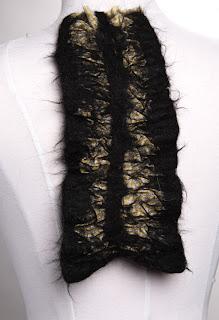Sorry for the delay in posting, but the past week I have been experimenting with my alpaca fiber. I have created two works and some some mini experiments. Some things worked great and others...not so good.
THE PREPARATION
I started my rub with my new alpaca roving with an experiment in how it dyes. I used both food coloring and kool-aid. I tried four colors on white alpaca roving and three colors on light fawn alpaca roving.
I started out by measuring off one ounce lengths of fiber. I zig-zagged the roving and tied it loosely at each end. I have been using hemp cord for this, mostly because I had it left over from another project.
I soaked them all in large bucket of 1:3 vinegar to water solution. I let them sort of float on the surface and then slowly - very slowly - pushed the wool into the solution using my whole hand to avoid any accidental felting.
I let this whole thing sit in my garage - where the vinegar water had been acclimating for a day or two - for about four hoursnwhile I ran errands for the day. I figured being out of the house would prevent me from messing with it and felting it on accident.
THE DYES
I mad the dyes using kool-aid and food coloring. The kool-aid colors where orange, red, and purple. The other colors were used creating Chef Master powder food coloring.
I created the dye by filling a pint jar (stolen from my husband's canning stash) with boiling water. For the kool-aid dyes I simply added packets of food coloring to the boiling water. For the food coloring, I added a hefty spoon of citric acid and "smidges" of food coloring powder. I have a set of very tiny measuring spoons that came with my last set of stainless spoons that are labelled "smidge", "pinch", etc. I stole them for my dyeing since we seldom use them for backing and they are perfectly tiny for measuring dye quantities.
I don't have my recipes for the dye yet, but I have a large batch of AmeriMist airbrush liquid color coming in the mail. I plan to dye a sample of each color and will blog those recipes exactly.
After mixing everything up well, I put on the canning lids and set everything in my garage to acclimate to the same temperature as the wool in the vinegar water bath. Everything sat for about 4 or 5 hours.
THE DYEING
After running my errands for the day, I setup my space. I decided to try dyeing in jars and using the steam method for setting they dye. I put each ounce of wool into a large jar and poured in enough dye to cover. I then put the lid on the jar and carefully turned it upside down and rightside up, then slowly rolled it to move the dye around the wool. Looking back on it, I should have untied the roving before putting in the jars as I got lines from the ties.
I put all of these in my large canning pot with the rack in the bottom - just the one that came with it turned upside down so the jars sit flat. I added enough water to almost reach the jars and then put on the heat. I put on the lid and after steam formed, I timed 35 minutes for the steaming.
Here are the pics of the wool in the pot:
After the wool was steamed, I took the jars out - VERY CAREFULLY!! I set them on the side and let them cool for about an hour: no touching = no felting. After that I turned the wool over on a baking cooling rack to drain the water and did not move it until it was room temperature. I then rinsed the wool using room temperature water and soaking it in small bucket about two times.
I hung it to dry on a clothes line. Here it is drying:
THE DYEING RESULTS
The four colors on the white roving came out pretty much exactly as I expected. The light fawn roving gave me mixed results. The red dye on the light fawn came out a wonderful shade of deep red. I love this color and will dye more like this. The purple and the blue dye came out very weird and spotty. The purple dye on the light fawn roving resulted in this odd muddy brown color with a hint of purple. The blue dye on the light fawn roving resulted in this yucky green color. I do end up "saving" these two colors by blending. More about that in Part Two.
I will be posting what I did with the wool in part two later this week.












